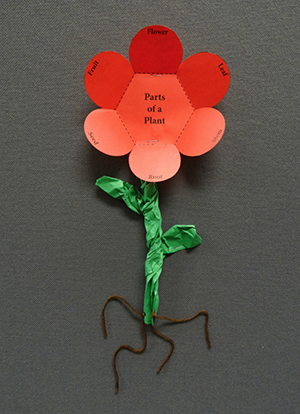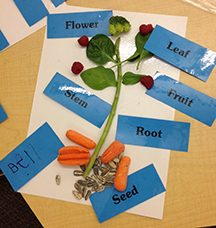Background Agricultural Connections
The fruits and vegetables we eat come from parts of plants. Flowering plants have six main parts—roots, stems, leaves, flowers, fruits, and seeds. Each plant part serves a different function.
- Roots act as anchors, holding a plant in place. They take up water and nutrients a plant needs from the soil. Roots can also store extra food for future use. Beets, carrots, radishes, and turnips are examples of edible roots.
- Stems provide support for leaves, flowers, and fruit. Water, nutrients, and sugars travel to and from other parts of the plant through the stem. Asparagus is a stem that can be eaten. Potatoes, often mistakenly thought to be roots, are actually enlarged underground stems called tubers.
- Leaves use energy from sunlight to carry out photosynthesis and make food for the plant. Edible leaves include arugula, cabbage, lettuce, mint, and spinach. Celery and rhubarb, commonly thought to be stems, are actually the part of a leaf called the leaf stalk or petiole.
- Flowers contain the parts of the plant necessary for reproduction and play an important role in pollination. The shapes, colors, and scents of some flowers attract insect and animal pollinators. Following pollination, the fertilization process occurs within the flower. During fertilization, the ovary swells and seeds are produced. The flowers of some plants are edible. Broccoli and cauliflower are flowers that can be eaten.
- Fruit is the part of the plant that contains seeds. This botanical definition includes many foods that are typically considered to be vegetables, such as cucumbers and green peppers, as well as more commonly recognized fruits, such as apples, oranges, bananas, and strawberries.
- Seeds have three parts—the embryo, the endosperm, and the seed coat. The embryo grows into a new plant, the endosperm provides nutrients for the embryo, and the seed coat is the protective outer covering that encloses the embryo. With proper conditions, seeds will grow into new plants. Corn, wheat, peanuts, black beans, and sunflower seeds are examples of edible seeds.
It is important for students to understand that not all roots, stems, leaves, flowers, fruits, and seeds are edible and that some may even be harmful to humans if eaten. Stress the importance of not eating parts of wild plants unless a trusted adult is confident that the plant parts are safe to eat.



